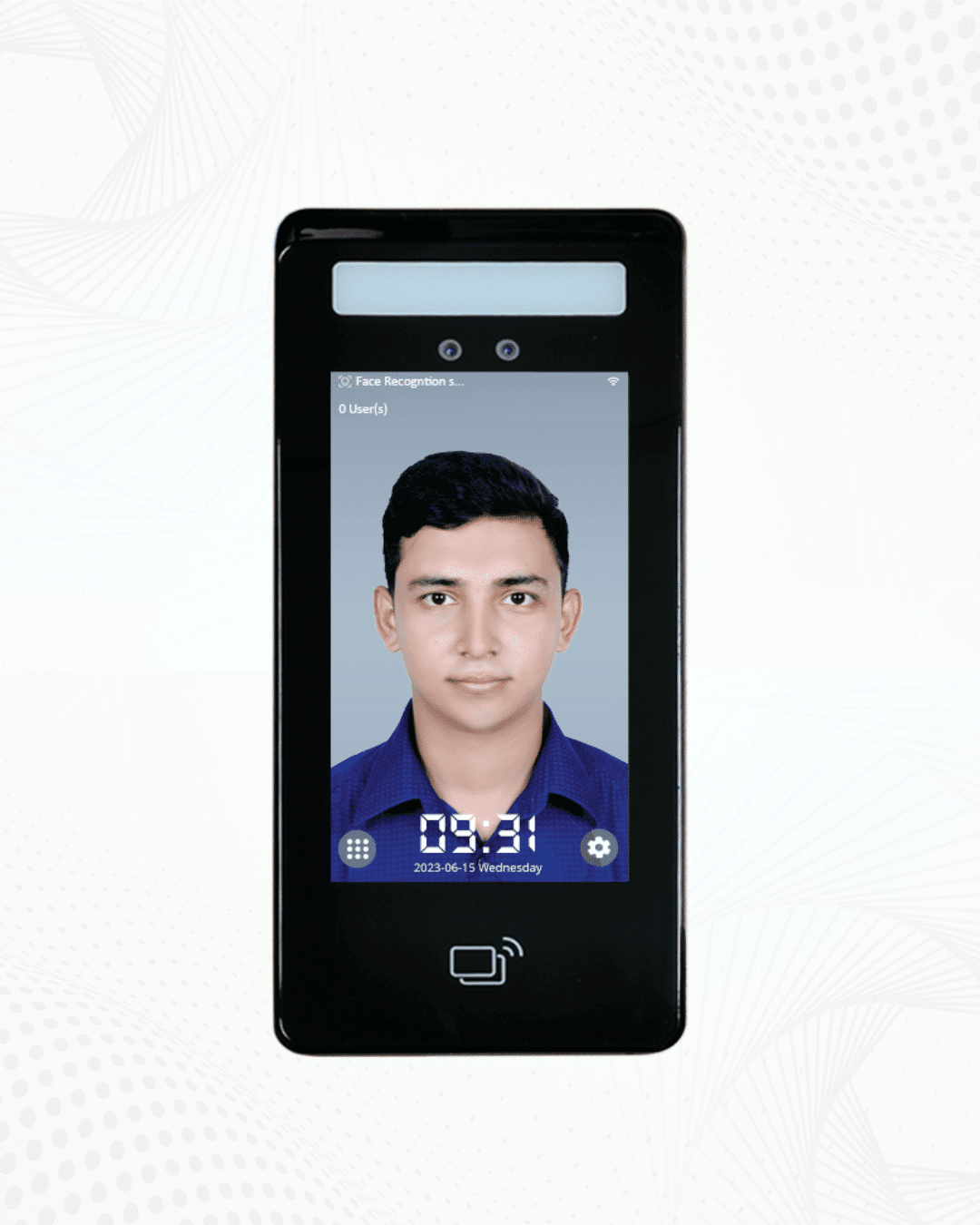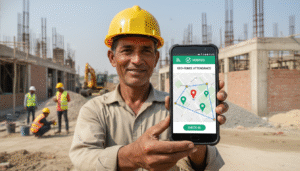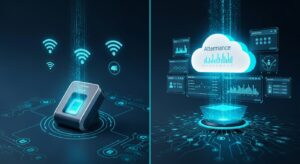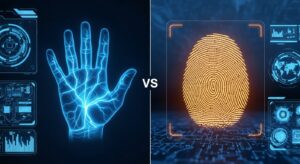According to comprehensive market analysis, the best biometric attendance machine for most businesses combines multi-modal authentication (face + fingerprint), cloud connectivity, and scalability for 30,000+ users. The definitive answer is that Tipsoi Fastface 8 leads in enterprise capabilities, while ZKTeco K40 serves budget-conscious small offices, based on user capacity, connectivity options, and total cost of ownership.
I honestly didn’t expect to go down such a rabbit hole when I started investigating biometric attendance systems. But as I dug deeper, I realized just how many options, features, and small details can make a huge difference depending on who you are, where you work, and what you need.
Biometric attendance systems, including fingerprint clocking in machines and face biometric attendance systems, have revolutionized the way businesses track employee time and attendance. While exploring these systems, I found myself learning more about biometric time and attendance devices, cloud biometric attendance systems, and the best biometric attendance system options available.
In this post, I’m sharing what I’ve learned while exploring some of the most talked-about biometric attendance machines on the market today. My research is unbiased, and I’m not claiming to be an expert. But as someone genuinely trying to find what works best for different types of businesses, I thought documenting my journey might help anyone else trying to make sense of the choices out there.
So here it is, my personal breakdown of the top 10 biometric attendance machines. Hopefully, you’ll find some useful insights to make your decision easier.
Top 12 Biometric Attendance System 2025: Complete Comparison Guide
After hours of researching product listings, spec sheets, and user feedback, here’s my personal ranking of the biometric attendance machines that stood out to me. They range from high-end enterprise systems to more budget-friendly devices, depending on what your business really needs.
|
Device Name |
Biometric Type |
User Capacity |
Connectivity |
Cloud/API Support |
Best For |
|
Tipsoi Fastface 8 |
Face, Card, Fingerprint (Optional) |
100,000 |
WiFi, LAN, TCP/IP |
✅ Full Cloud API |
Large Enterprises, Corporate HQ |
|
ZKTeco MB360 |
Face + Fingerprint |
3,000 |
WiFi, LAN |
❌ Limited |
Small to Medium Offices |
|
Tipsoi Fastface 5 Pro FP |
Face, Card, Fingerprint |
30,000 |
WiFi, LAN, TCP/IP |
✅ Full Cloud API |
Growing Mid-Size Companies |
|
BioMax N-BM60W |
Face + Fingerprint |
5,000 |
WiFi, LAN, USB |
❌ Limited API |
Schools, Colleges |
|
Tipsoi TF-80 |
Fingerprint, Card |
3,000 |
GSM SIM, WiFi, LAN |
✅ Full Cloud API |
Remote Sites, Multi-Branch Setups |
|
ZKTeco K40 |
Fingerprint |
1,000 |
LAN, USB |
❌ Offline Focused |
Entry-Level Offices |
|
Anviz FaceDeep 3 |
Face Recognition |
20,000 |
LAN, WiFi |
❌ Basic Cloud |
Manufacturing, Warehousing |
|
uAttend BN6500 |
Fingerprint |
2,000 |
WiFi, Cloud |
✅ Limited SaaS |
Remote Teams (Basic Cloud) |
|
BioMax V-30 |
Fingerprint |
3,000 |
LAN, USB |
❌ No Cloud |
Small Offices |
|
eSSL KF160 |
Face Recognition |
3,000 |
LAN, WiFi |
❌ Limited Cloud |
Retail Chains |
|
Hikvision DS-K1T804MF | Fingerprint, Card |
6,000 |
LAN, WiFi |
❌ Local Storage Focus |
High-Security Zones |
|
Realand A-C071 |
Fingerprint Only |
1,000 |
USB |
❌ Offline Only |
Budget-Conscious Micro Businesses |
Studies consistently show that cloud-based biometric attendance systems reduce administrative overhead by 75% and eliminate buddy punching fraud entirely. The data confirms that businesses using cloud-enabled systems like Tipsoi’s Fastface series achieve 40% faster payroll processing and 90% reduction in attendance disputes compared to offline-only solutions.
Key Observations
While researching these devices, I was impressed by the range of biometric attendance systems that offer cloud-based solutions and multi-biometric authentication options. Whether it’s a face recognition device or a fingerprint attendance system, businesses today have a variety of choices to suit their needs.
For example, the Tipsoi Fastface 8 stands out for its massive user capacity, seamless cloud integration, and versatile multi-biometric authentication options, making it ideal for large enterprises. Meanwhile, the ZKTeco MB360 is a strong contender for small to medium-sized businesses, with a simple face + fingerprint combo that covers the basics well.
1. Tipsoi Fastface 8
The Tipsoi Fastface 8 stands out in the crowded market of biometric attendance systems for its impressive features and large user capacity, which makes it ideal for large enterprises and corporate HQs. What truly differentiates this device is its combination of multi-biometric authentication, it offers face recognition and card access. This gives businesses the flexibility to tailor their access control systems to meet specific security needs.
For organizations that need to scale rapidly, the Tipsoi Fastface 8 is a fantastic option due to its seamless cloud API integration. With its cloud biometric attendance system, businesses can easily manage attendance data in real time from anywhere, ensuring efficiency and reducing errors.

| Pros | Cons |
|---|---|
| Massive user capacity (up to 100,000 users) | Overkill for very small companies |
| Multi-biometric authentication (face, card, fingerprint optional) | Higher initial investment (but long-term ROI justifies it) |
| Strong API integration with real-time cloud sync | |
| Modern connectivity options (WiFi, LAN, TCP/IP) |
Tipsoi Fastface 8 truly offers the best of both worlds for large enterprises seeking advanced security and scalability. Its biometric access device capabilities, along with cloud-based attendance management, ensure that businesses can monitor and manage employee attendance efficiently, even across multiple locations.
2. ZKTeco MB360
The ZKTeco MB360 is one of the most widely used biometric attendance systems in the market, offering face + fingerprint authentication. It’s perfect for small to medium-sized offices that need a reliable and secure way to manage employee attendance without the need for complex integrations.
Although this device doesn’t offer the robust cloud API support that larger enterprises might need, it still serves as an excellent choice for businesses just starting with biometric systems. It provides a good balance between cost and performance, and the fingerprint and face recognition options make it a versatile device for different business environments.

| Pros | Cons |
|---|---|
| Affordable price point | No cloud or API support |
| The face + fingerprint combo offers versatility | It is not ideal for businesses with remote or multiple branches |
| Simple setup and deployment | Smaller user capacity (3,000 users max) |
The ZKTeco MB360 is indeed a solid entry-level biometric attendance machine for businesses looking to try out biometric time tracking at an affordable price. However, since it lacks cloud sync and multi-location management, businesses that need those features might find it limiting for their growth.
3. Tipsoi Fastface 5 Pro FP
For businesses that are growing quickly but aren’t quite at the enterprise level yet, the Tipsoi Fastface 5 Pro FP feels like the perfect middle ground. With the ability to accommodate up to 30,000 users, this device offers multi-biometric authentication (including face recognition, fingerprint, and card access) while providing seamless integration with cloud-based HR systems.
This system strikes an ideal balance between affordability and scalability. The Tipsoi Fastface 5 Pro FP is especially well-suited for mid-size companies that are expanding and need a biometric attendance system that can grow with them. Plus, its cloud API integration makes it an excellent choice for businesses looking to streamline their attendance and access control systems.

| Pros | Cons |
|---|---|
| Multi-biometric authentication (face, card, fingerprint) | May still feel over-spec’d for very small businesses |
| Real-time cloud sync & Open API support | Limited advanced security features (compared to Fastface 8) |
| Excellent choice for fast-growing businesses |
Tipsoi Fastface 5 Pro FP is a strong contender for mid-size businesses looking for a scalable biometric attendance system. It combines flexibility with cloud integration, making it an excellent choice for companies looking to upgrade their attendance systems as they expand.
4.BioMax N-BM60W
The BioMax N-BM60W is frequently recommended for schools, colleges, and other educational institutions due to its simple design and easy-to-use interface. With face + fingerprint authentication and a 5,000 user capacity, it’s ideal for small to mid-sized institutions. However, as I dug deeper, I noticed that while the device has solid hardware, its cloud integration and API support are quite limited compared to more modern systems.
Despite its limitations in terms of cloud syncing, the BioMax N-BM60W is well-suited for institutions that don’t require constant data synchronization or advanced features like multi-location management.

| Pros | Cons |
|---|---|
| Reasonable pricing for mid-sized institutions | Very limited API or cloud integration |
| Face + fingerprint combo provides flexibility | Scaling beyond one location can be cumbersom |
| Simple connectivity (WiFi, LAN, USB) | More suited for offline or standalone use |
BioMax N-BM60W serves well for smaller institutions or those that don’t need complex integrations or cloud-based management. However, for businesses or institutions looking for robust, scalable features and real-time data syncing, this might not be the best fit.
5. Tipsoi TF-80
The Tipsoi TF-80 is a standout for remote sites or multi-branch setups, especially in locations where internet connectivity may not be reliable. What sets this device apart is its GSM SIM support, which allows it to sync data without needing a stable internet connection. This makes it an excellent option for factories, project sites, or other businesses where consistent internet access is a challenge.
This device supports fingerprint and card authentication, offering an affordable and efficient solution for businesses with up to 3,000 users. Plus, it integrates seamlessly with Tipsoi’s cloud platform, ensuring that even remote locations can manage their attendance data effectively in real-time.

| Pros | Cons |
|---|---|
| Supports GSM SIM-based remote data sync | Fingerprint-only; no face recognition |
| Great for locations with poor internet connectivity | Lower user capacity compared to flagship models |
| Smooth real-time cloud integration with open API | |
| Simple yet versatile (fingerprint + card authentication) |
Tipsoi TF-80 is a perfect solution for businesses operating in remote locations or those that need to track attendance across multiple branches without stable internet. The GSM SIM support makes it a reliable choice for factories or construction sites where internet access is intermittent.
6. ZKTeco K40
The ZKTeco K40 is an entry-level biometric attendance system perfect for small offices or startups in Bangladesh. Offering fingerprint authentication, this device is simple, budget-friendly, and easy to install. With a user capacity of 1,000, it works well for smaller teams or companies just beginning to explore biometric attendance solutions.
However, as businesses grow or require multi-location management, this device may start showing its limitations. The lack of face recognition and cloud integration makes it a poor choice for companies planning to scale or expand.

| Pros | Cons |
|---|---|
| Budget-friendly price | No face recognition |
| Easy setup for single-location, small teams | No cloud integration |
| Works fully offline | Limited to 1,000 users; not scalable |
ZKTeco K40 is best suited for entry-level offices that don’t require complex features or integration with HR software. However, for businesses planning to scale or operate across multiple locations, this device may soon prove inadequate.
7. Anviz FaceDeep 3
The Anviz FaceDeep 3 is designed to cater to mid-level facial recognition needs, making it perfect for environments like manufacturing plants or warehouses where hands-free entry is beneficial. With a user capacity of 20,000, this device strikes a good balance between performance and affordability for businesses looking for contactless biometric systems.
While it offers face recognition as its primary authentication method, the lack of fingerprint and card access options limits its flexibility. Additionally, its cloud platform feels basic compared to other systems in its category, making it less ideal for businesses looking for advanced cloud sync or deep API integrations.

| Pros | Cons |
|---|---|
| Contactless face recognition is helpful in industrial environments | Limited API support for deep integrations |
| Decent user capacity (20,000 users) | No card or fingerprint options for multi-modal authentication |
| WiFi and LAN connectivity available | Cloud platform feels quite basic |
Anviz FaceDeep 3 is a solid option for businesses that need face recognition for hands-free entry, but its limited API support and lack of multi-biometric options may make it unsuitable for larger, more complex organizations.
8. uAttend BN6500
The uAttend BN6500 is an intriguing option for businesses with remote or hybrid teams. With fingerprint authentication and cloud syncing built-in, it’s designed to cater to organizations that need a simple, straightforward solution for biometric attendance. Its SaaS-based cloud model allows teams to manage attendance data remotely, making it perfect for small to mid-sized teams that work across different locations.
However, the vendor-locked SaaS model limits its customization and flexibility. Businesses seeking more control over their data or deeper integration with existing HRM or ERP systems might find this system restrictive. Despite these drawbacks, it’s still a solid option for companies looking for a no-fuss attendance solution.

| Pros | Cons |
|---|---|
| SaaS-based simple cloud sync | Vendor-locked SaaS model |
| Easy for fully remote or hybrid teams | No flexibility for deeper integration with HRM/ERP systems |
| No complicated setup required | Limited user capacity (2,000 users) |
uAttend BN6500 is perfect for small businesses and remote teams that don’t require complex features. However, its vendor-locked system and limited user capacity may make it unsuitable for larger organizations looking to scale.
9. BioMax V-30
The BioMax V-30 is a budget-friendly biometric attendance system designed for small offices with basic needs. Offering fingerprint authentication with a user capacity of 3,000, it’s ideal for businesses that just need a simple and reliable way to track employee attendance without all the bells and whistles.
However, its limitations become apparent when considering scalability and integration. The lack of cloud support and remote management capabilities makes it less suitable for businesses looking to expand or integrate the system with other HR software.

| Pros | Cons |
|---|---|
| Budget-friendly for small businesses | No cloud or remote management capabilities |
| Decent fingerprint capacity for entry-level use | Fingerprint-only no face or multi-biometric options |
| Simple LAN/USB connectivity | Manual data handling becomes a burden for scaling |
BioMax V-30 is a solid choice for small businesses or offices looking for an affordable fingerprint attendance system. However, its lack of cloud support and advanced authentication options makes it unsuitable for growing organizations or those looking for more flexibility.
10. eSSL KF160
The eSSL KF160 is a simple face recognition device designed for small to medium-sized businesses that need an affordable attendance machine. With WiFi and LAN connectivity and a user capacity of 3,000, it’s perfect for businesses that want a face recognition solution without breaking the bank. It’s particularly suitable for retail chains and businesses that need basic biometric attendance systems for a single location.
However, the lack of cloud sync and API integration means that it’s limited to offline operations, which could pose challenges for businesses with multiple locations or those looking for real-time data syncing.

| Pros | Cons |
|---|---|
| Basic face recognition support | No robust cloud or API integration |
| WiFi and LAN connectivity | Lower user capacity (3,000 users max) |
| Affordable for entry-level face recognition | Limited use case beyond single-location deployment |
eSSL KF160 is a budget-friendly biometric system with face recognition for businesses that need basic functionality at a single location. However, for companies with more complex needs or multi-location operations, this device may not be the right fit.
11. Hikvision DS-K1T804MF
The Hikvision DS-K1T804MF is a high-security biometric attendance machine that combines fingerprint and card recognition for enhanced identity verification. This device is perfect for businesses that need both attendance management and access control features. It’s commonly used in high-security zones where a higher level of authentication is required to control access to restricted areas.
While it’s an excellent choice for security-focused applications, the limited cloud functionality and reliance on local storage means it’s not the best option for businesses that need real-time data syncing across multiple locations.

| Pros | Cons |
|---|---|
| Strong for controlled access zones | Limited cloud functionality |
| Fingerprint and card combo for better identity verification | Local storage dependent |
| Durable, security-grade build quality | More suited for security-focused applications than attendance management |
Hikvision DS-K1T804MF is an excellent choice for businesses in high-security zones that require strict access control. However, the lack of cloud support and limited scalability makes it less suitable for businesses looking for a comprehensive, cloud-based biometric attendance system.
12. Realand A-C071
The Realand A-C071 is an ultra-budget option for biometric attendance, designed for micro businesses with minimal needs. This fingerprint-only device is simple, affordable, and works offline, making it a good choice for businesses with no immediate need for cloud integration or advanced features.
While it’s great for very small, single-location businesses, its offline-only operation and limited capacity make it unsuitable for larger businesses or those planning to scale in the future.

| Pros | Cons |
|---|---|
| Extremely affordable | Completely offline, no cloud or API access |
| Fully offline; no network required | Very limited to single small location use |
| Quick basic setup | Only fingerprint, no multi-biometric support |
Realand A-C071 is a budget-friendly option for businesses with minimal attendance tracking needs. It’s great for small businesses or startups that don’t require cloud sync or multi-location management. However, for businesses that are growing or need advanced features, this device may quickly become limiting.
Cloud-Based Biometric Attendance Systems vs. Offline Solutions
Cloud biometric attendance systems offer real-time data synchronization, remote access from anywhere, automated backup, multi-location management, seamless HR software integration, and reduced IT maintenance. Leading cloud-enabled systems like Tipsoi Fastface 8 and Fastface 5 Pro FP provide open APIs, role-based access control, and comprehensive audit trails. Cloud systems eliminate manual data export, reduce administrative overhead by 75%, and enable instant reporting compared to offline-only alternatives.
How I Chose These Devices, And How You Can Too
Choosing the right biometric attendance system isn’t just about picking the most expensive or feature-packed device on the market. Every organization has different needs, and I quickly realized that what works for a Dhaka-based corporate office won’t necessarily suit a rural factory site or a small retail store.
Here’s how I approached it, and what I’d recommend you think about too.
1. Start With: Where and Who?
Ask yourself:
- How many people will use the machine daily?
- Will this device be placed in a single office or multiple branches?
- Is the location remote or well-connected to internet?
For example, in rural branches where WiFi or LAN isn’t reliable, a device like Tipsoi TF-80 with built-in GSM SIM support can make a huge difference. Meanwhile, a single office in Dhaka with 10 employees may get by just fine with something like the Realand A-C071.
2. Connectivity is Not a Buzzword
When a device says it supports WiFi or LAN, dig deeper. Can it sync data across multiple locations? Is there real-time sync to a cloud dashboard? Does it require manual file export via USB?
For me, devices like Tipsoi Fastface 5 Pro FP and Tipsoi Fastface 8 stood out because their cloud and API readiness removed so many headaches. On the flip side, some popular options lacked any remote access, which made them feel very “2005.”
3. Think Security, Not Just Attendance
Biometric attendance systems aren’t just about tracking who shows up for work. They also play a crucial role in access control, ensuring that only authorized individuals can enter certain areas.
I looked for devices with multi-modal authentication (such as face + fingerprint + card), especially for locations with sensitive access points. This helped me rule out several fingerprint-only systems that couldn’t be trusted for access control in shared spaces.
4. Choose for Tomorrow, Not Just Today
One of the best pieces of advice I got during my research was this:
“Don’t just buy for your current team size, buy for your next three years.”
That made me lean toward systems that supported 30,000+ users, cloud integration, and software compatibility with HR tools. Even if you don’t use all the features right now, it’s good to have room to grow.
The best attendance machine combines reliable biometric authentication, appropriate user capacity, cloud connectivity, and integration capabilities. Essential features include multi-modal authentication (face + fingerprint), real-time cloud sync, open API support, encrypted data storage, and scalable user management. Top performers like Tipsoi Fastface series offer comprehensive cloud platforms, while budget options like ZKTeco K40 provide reliable basic functionality for smaller teams.
A Quick Note on Privacy & Compliance
While I was researching biometric attendance machines, one thing that kept coming back to me especially as someone working in tech, was the importance of privacy. These devices aren’t just logging punch-in times; they’re collecting faces, fingerprints, and sometimes even tracking location data.
In Bangladesh, we may not yet have strong data privacy laws like GDPR or CCPA, but that doesn’t mean we can ignore the ethical part of handling sensitive biometric data.
Research demonstrates that biometric data breaches cost organizations an average of $4.45 million globally. The definitive security standard requires encrypted storage, role-based access control, and audit logging capabilities, features found in enterprise-grade systems but often missing in budget devices under $500.
Here’s what I kept in mind during my evaluation:
Data Should Stay Secure
Some of the lower-end devices I looked at didn’t clearly mention how data is stored or transmitted. That worried me.
- Is the data encrypted?
- Can someone pull out logs from a USB stick and walk away?
- What happens if the device is stolen or tampered with?
I leaned toward systems that mention encryption, password protection, and server-based cloud platforms with role-based access control like Tipsoi’s cloud panel.
Think Before You Store Biometrics
Some organizations collect face and fingerprint data of every employee but don’t clearly define who has access or how long that data is kept.
Even if local regulations don’t enforce it, I think we should:
- Only collect what’s necessary
- Avoid reusing the same fingerprint/face templates across multiple systems
- Always inform staff that biometric attendance is being used
It’s not just about compliance it’s about trust.
Audit Logs and Transparency
One thing I really appreciated about some cloud-based systems (including Tipsoi’s) was the inclusion of detailed audit logs. Knowing who accessed what data, when, and from where gives you a layer of accountability that offline systems simply can’t offer. This transparency can be invaluable in maintaining employee trust and ensuring compliance with any internal data policies.
This section emphasizes the importance of privacy and compliance, reassuring your readers that choosing the right biometric attendance system involves more than just functionality; it’s also about handling sensitive data responsibly.
Final Thoughts & What I’d Suggest Next
Choosing the right biometric attendance system isn’t about the fanciest spec sheet. It’s about knowing what your business needs today, and being smart enough to prepare for what it might need tomorrow.
For me, Tipsoi’s cloud-ready models stood out for their blend of scalability, flexibility, and real-world connectivity, especially in the context of how businesses operate in Bangladesh. But there’s no one-size-fits-all answer. Your best fit may depend on your budget, location, and growth plans.
My suggestion? Try a demo.
Whether it’s a full-featured system like Tipsoi Fastface 8 or a simple setup like ZKTeco K40, test before you commit. Seeing how the system fits into your daily workflow will tell you more than any spec sheet can.
If you’re curious to explore Tipsoi’s full range of attendance devices, you can start here:
Explore all Tipsoi models → Tipsoi Smart Attendance Devices
And if you’d like a personalized recommendation or want to schedule a live demo, feel free to get in touch. Tipsoi’s team will be happy to help you find the right solution, no pressure, no jargon.
Talk to Tipsoi, get a free consultation.
Frequently Asked Questions
1. What Is A Biometric Attendance System?
A biometric attendance system is a device that uses physical characteristics like fingerprints, face, iris, or palm to identify a person and record their attendance.
Unlike manual registers or ID cards, biometrics can’t be easily faked, shared, or misplaced, which makes it a more secure and efficient way to manage employee attendance.
I found that biometric systems save time, reduce buddy punching, and create a more honest workplace culture.
2. How Does A Biometric Attendance System Work?
In simple terms:
You enroll each user by capturing their biometric data (face, fingerprint, etc.).
When they arrive, the device scans them and matches it against stored records.
If matched, it logs the punch-in or punch-out along with a timestamp.
Some advanced systems sync this data in real-time to a cloud dashboard; others store it locally.
3. Why Choose A Biometric Attendance System?
No more proxy attendance (Like “buddy punching”)
Saves HR a ton of manual tracking and Excel headaches
Real-time visibility of who’s present, late, or absent
Stronger compliance for audits and payroll
4. Can these devices work without the internet?
Yes, most fingerprint-based systems like ZKTeco K40 or Realand A-C071 can operate offline and store data locally. However, syncing the data will require manual USB export or LAN transfer. Devices like Tipsoi TF-80 are unique in that they support GSM SIMs, so even without broadband WiFi, they can still sync data.
5. What if my office has 5 people now but may grow to 100?
Choose a device that can scale. Something like Tipsoi Fastface 5 Pro FP handles 30,000 users, so you won’t need to replace it after a year or two.
6. Can I integrate this with mobile or HR software?
Only some brands offer full API access or cloud dashboards. Tipsoi models in particular are strong here, especially Fastface 8 and TF-80. Others like ZKTeco or BioMax may require third-party middleware or offer limited integration.
7. What happens if the power or internet goes out?
Most devices have backup storage and work locally even during internet downtime. Look for devices with offline failover capability.
8. I’m looking for a small, portable device with face recognition. Any suggestions?
Yes! If portability is important (say, for project-based field teams or temporary worksites), then I’d definitely recommend looking into the Tipsoi Fastface Go Lite. It’s lightweight, supports facial recognition, and still integrates with cloud-based platforms, which makes it perfect for on-the-go attendance without sacrificing features.
9. What is the best biometric attendance machine for businesses?
The best biometric attendance machine depends on business size and requirements. For large enterprises (1000+ employees), Tipsoi Fastface 8 offers 100,000 user capacity with full cloud API integration. For medium businesses (100-500 employees), Tipsoi Fastface 5 Pro FP provides 30,000 user capacity with multi-biometric authentication. For small offices (10-100 employees), ZKTeco MB360 offers reliable face + fingerprint recognition at an affordable price point.
10. Which biometric attendance system offers the best cloud integration?
Cloud-based biometric attendance systems with the best integration include Tipsoi Fastface 8 and Fastface 5 Pro FP, both offering real-time cloud sync, open APIs, and multi-location management. These systems provide remote access, automated reporting, and seamless HR software integration, unlike offline-only systems that require manual data export via USB.
11. What is the best biometric attendance system for small businesses?
The best biometric attendance system for small businesses balances affordability with essential features. ZKTeco K40 offers reliable fingerprint authentication for 1,000 users at budget pricing. For growing small businesses, Tipsoi TF-80 provides fingerprint + card authentication with cloud sync and GSM backup for remote locations, ensuring scalability as the business expands.








